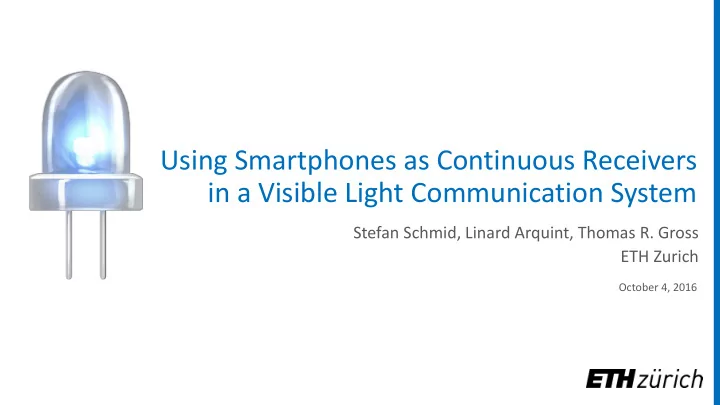

Using Smartphones as Continuous Receivers in a Visible Light Communication System Stefan Schmid, Linard Arquint, Thomas R. Gross ETH Zurich October 4, 2016
Smartphone as a Light Receiver • No light sensor • Ambient light sensor cannot be directly accessed and/or be sampled fast enough • Additional peripheral is impractical • Camera is the only option left • Sampling rates up to 240 Hz (FPS) • Exploiting the rolling shutter effect 2
Outline Motivation libvlc & EnLighting Rolling Shutter Real-Time Decoder Evaluation Conclusion 3
libvlc & EnLighting EnLighting libvlc S. Schmid et al. “LED -to- LED Visible Light Communication Networks”, 2013 S. Schmid et al. “Continuous Synchronization for LED -to- LED Visible Light Communication Networks”, 2014 S. Schmid et al. “ EnLighting : An Indoor Visible Light Communication System Based on Networked Light Bulbs”, 2016 4
PHY Layer – Communication and Illumination • Illumination (ILLU) slots and communication (COM) slots are COM ILLU COM ILLU COM ILLU COM ILLU COM ILLU COM ILLU COM ILLU ILLU COM alternating 1000µs Communication Slot Illumination Slot • ILLU slots are used to provide the S 1 G D 1 G G D 2 G S 2 necessary light output for illumination C M C M C M C M S 1 , S 2 : Synchronization intervals • During COM slots, there is either G: Guard interval no light output while sensing or D 1 , D 2 : Data intervals light output is enabled during data C: Charge (reverse bias) LED intervals while transmitting M: Measure remaining voltage • Light is sensed during the synchronization (S 1 , S 2 ) and data (D 1 , D 2 ) intervals 5
PHY Layer – Constant Light Output COM ILLU COM ILLU COM ILLU COM ILLU COM ILLU COM ILLU COM ILLU ILLU COM 50% light >50% light 50% light ILLU D C D C D C D C D C D 1000µs 6
PHY Layer Modes Communication Slot S 1 G D 1 G D 2 G S 2 SINGLE 50µs 170µs S 1 G D 1,1 D 1,2 G D 2,1 D 2,2 G S 2 DOUBLE 85µs S 1 G D 1,1 D 1,2 D 1,3 D 1,4 G D 2,1 D 2,2 D 2,3 D 2,4 G S 2 QUAD 42µs S 1 G D 1,1 D 1,2 D 1,3 D 1,4 D 1,5 D 1,6 D 1,7 D 1,8 G D 2,1 D 2,2 D 2,3 D 2,4 D 2,5 D 2,6 D 2,7 D 2,8 G S 2 OCTA 21µs • Shorter data intervals require more precise synchronization • LEDs receive less light during shorter data intervals (lower signal strength) • PHY layer mode can be selected dynamically 7
Rolling Shutter (I) • • Global shutter Rolling shutter • • Complete image sensor is exposed at the Image sensor is exposed line by line • same time Captures multiple moments in time • Captures one moment in time [Image Source: Point Grey Research Inc.] 8
Rolling Shutter (II) – Recorded Frame 500 µs Sensor line 1 Sensor line 720 Rolling shutter extends the camera’s sampling rate (FPS) 9
Intra-Frame Gap • Gap between two consecutive frames • No light can be received • Gap duration depends on camera and camera mode • Higher frame rates reduce gap width • Slow-motion capturing (240 FPS) for smallest gap 10
Intra-Frame Gap Measurement Light source is enabled for the duration of half a frame (example): 1. Light pulse is completely visible (417 pixels) 2. Light pulse is partly visible (152 pixels) 3. Remaining part of the light pulse is visible in the next frame (175 pixels) 90 pixels are missing; results in a gap of approximately 450 µs (measured on an iPhone 6s at 240 FPS) 11
Redundancy • Gap duration is (on average) shorter than 500 µs (240 FPS) • Missing data intervals can be reconstructed 12
Protocol & Rolling Shutter PHY mode: SINGLE PHY mode: DOUBLE 13
Real-Time Decoder (iOS Application) 1. Exposure adaptation 4. Inter-frame handling 2. Gradient detection 5. Bit processing 3. Slot detection 6. Error detection / correction 14
Testbed Setup 1. iPhone 6s (receiver) running the real-time decoder application 2. Light source (transmitter) connected to a microcontroller (running the VLC protocols) 3. White wall: illuminated by the transmitter and captured by the receiver 15
Throughput – PHY mode SINGLE • Stable communication up to 2.75 m • 750 b/s saturation throughput 16
Throughput – PHY mode DOUBLE • Stable communication up to 2.75 m • 1300 b/s saturation throughput 17
Related Work • J. Ferrandiz-Lahuerta et al. “A Reliable Asynchronous Protocol for VLC Communications Based on the Rolling Shutter Effect” , 2015 • 700 b/s, up to 3 m, reflection • H.-Y. Lee et al. “ RollingLight: Enabling Line-of-Sight Light-to-Camera Communications” , 2015 • FSK, multiple light sources (direct), 90 b/s, up to 5 m • P. Hu et al. “ ColorBars: Increasing Data Rate of LED-to-Camera Communication using Color Shift Keying” , 2015 • CSK, 5.2 kb/s 18
Conclusions • Integration of a smartphone (camera) as a receiver into an existing VLC system • Flicker-free light source • Exploiting slow-motion capturing (240 FPS) and rolling shutter • Real-time decoder implemented as an iOS application • Communication distances up to 3 m • Data throughput up to 1300 b/s 19
? 20
Recommend
More recommend